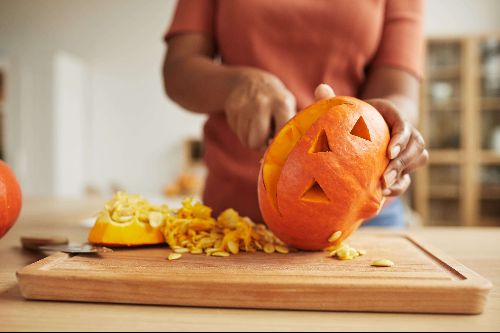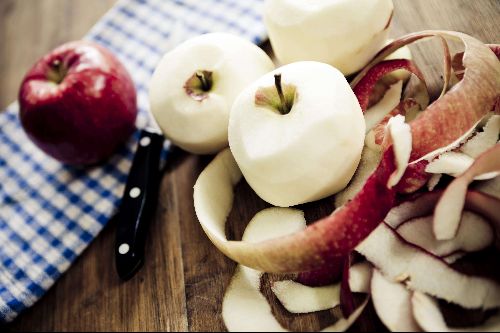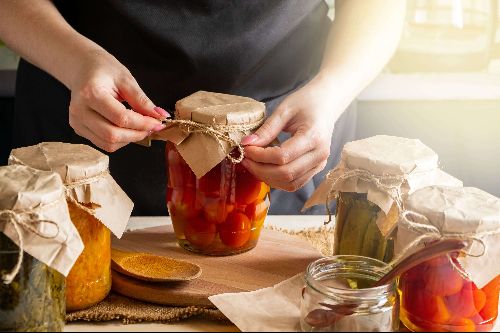Don’t get caught off-gourd with living sustainably this Fall! With cooler temperatures breezing in, so are new ways to reduce food waste and keep your home running sustainably.
About 35% of food in the United States goes unsold or uneaten. Of that, 43% of food waste – 27 million tons annually – occurs at home. Each year, American consumers spend $144 billion dollars on food that they ultimately just throw away.
Making small changes in your lifestyle is a simple, yet effective way to live a more sustainable life. Less food waste overall means more food in the stomachs of the 38 million food insecure Americans, as well as a healthier ecosystem.
Here are 6 ways you can live sustainably this Fall...
Shop Locally
Purchasing fruits and veggies from your local farmer's market is the best way to buy fresh, ripe, and seasonally appropriate foods. It’s also a great way to support local small businesses and farms. Don’t forget to bring your reusable grocery bags!
If you don’t have a local farmer’s market, many grocery stores buy produce from local farms. Buying locally purchased foods from grocery stores is a good alternative to support local communities.
Save the guts (and seeds)!
Decorating pumpkins and creating Jack O’ Lanterns for Halloween is a super fun way to get into the Fall spirit. But did you know that over 1 billion pumpkins are thrown away each year - with most being thrown away shortly after Halloween? The great news is each part of the pumpkin can be used in a variety of different ways without having to throw them away.
When carving your pumpkin, make sure to save the guts and seeds in a container. Pumpkin seeds become a delicious snack when roasted - make sure to use seasoning to make them even yummier!
Pumpkin guts can be pretty versatile and used for an arrangement of recipes throughout the year.

Here are 4 different ways you can use your pumpkin guts:
- Have a “pumpkin smash” party and fertilize your yard. Halloween is officially over and the pumpkins decorating your doorstep look sadder every day, so what better way to get rid of your pumpkins than having a pumpkin smash party in your yard? The steps are simple; place pumpkins in yard, use whatever tools preferred (bat, stick, hands, feet) to smash the pumpkin into pieces, leave pumpkin pieces to degrade and act as a natural fertilizer for your yard.
- Save it for broth. Save the pumpkin with your other stockpiled veggies in the freezer for a fun flavor to your veggie broth!
- Make a yummy Pumpkin Hummus! Sauté the pumpkin pulp with oil, then purée with canned chickpeas to make a delicious hummus (add cinnamon, nutmeg, cloves, allspice, and ginger when pureeing to make a Pumpkin Spice Hummus).
- Make a face mask. Did you know pumpkins are packed with vitamins, zinc, and antioxidants? Just puree the pumpkin guts and add in other ingredients, like honey, sugar, or coffee, for a DIY face mask that will leave your skin glowing.
The Apple of Your Pie
Apple picking is a favorite Fall-themed activity for many people. From picking baskets (upon baskets) of apples to fresh apple pies to delicious caramel apples, it’s understandable that many go home with more apples than they know what to do with.
Luckily (and similarly to pumpkins), apples can be used in many different ways without ever having to go into the trash can.
Here are 5 ways to get the most out of your apples:
- Make sure you're storing them correctly. Apples prefer the cold and produce natural gas that could be harmful to other fruits and veggies. Store them by themselves in a crisper drawer in the fridge for long-lasting apples.
- Use apple peels to make Apple Cider Vinegar. All you need are apple skins, a clean jar with at least 1 liter volume, a kitchen cloth, and a rubber band. Learn more about making Apple Cider Vinegar here.

- Use them in a recipe. There are so many different recipes out there with apples as the main character; apple pie (and mini apple pies), apple strudel, caramel apples, apple cobbler, apple crisps - the list goes on and on. (Psst - they’re all equally delicious too!).
- Eat the whole apple. The way people eat apples is actually incorrect. Eating the entire apple (including the core) is a completely zero-waste way to eat apples. Eating pole to pole will make the seeds barely noticeable, and give you about 30% more apple. The rumor that apple seeds are poisonous isn’t entirely true - according to Food Print, “while apple seeds do contain amygdalin, which can convert into cyanide when apple seeds are crushed or chewed, the amount is extremely low. Which means you’d have to eat a ton of apple seeds to be affected by the cyanide inside of them.”
- Make apple syrup. Use your apple scraps (peels and core) to make a delicious apple syrup that can be used on pancakes or over apple crisps (don’t forget vanilla ice cream). Learn how to make it here.
Trick or (eco-friendly)Treats
Each year, more than 600 million pounds of Halloween candy is purchased by Americans - and most of that is individually wrapped in plastics. Instead of contributing to the mountain of candy given out yearly, here are a few different options you can give out as sustainable treats:
- Halloween-themed fruits (dipped in sugar, obviously). Chocolate-covered apple slices or pumpkin-look-a-like mandarin oranges are a relatively healthy treat to give out to your neighborhood ghosts and goblins.
- Fun, unedible treats. Opt for small bags of sidewalk chalk, coloring sheets, and crayons are a great way to still hand out items kids will enjoy.
- Hand out seeds. Create little bags of different types of seeds (like herbs, pumpkins, or flowers) and include a small sheet on how to grow their own plants.
- Buy Halloween candy that’s as eco-friendly as possible. We know handing out homemade treats may not be feasible (for safety reasons), so opting for the next best thing will have to do. Look for Halloween treats that are organic, sustainably harvested, and packaged with recyclable materials. Finding candy that checks off all 3 boxes may feel impossible to achieve, so here are a few types of candy that are sustainable to buy:
- The first one isn’t a candy, but using a Zero Waste TerraBox to collect snack and candy wrappers will allow you to collect your hard-to-recycle materials, and ship it to TerraCycle to have them safely and sustainably recycled into something awesome. Learn more about TerraCycle here.
- Glee Gum is a candy that’s both eco-friendly and socially responsible. Made with sustainably harvested chicle (tree sap) and without artificial colors, flavors, sweeteners, or preservatives, this gum is parent and kid approved.
- YumEarth Organic brand is a fantastic brand to buy from. With a versatile spread of options, from lollipops, to gummy packs, to fruit chews, their products are vegan, USDA Organic, gluten-free, Non-GMO Project Verified, made without artificial flavors or colors, and free from the top 8 food allergens.
- The first one isn’t a candy, but using a Zero Waste TerraBox to collect snack and candy wrappers will allow you to collect your hard-to-recycle materials, and ship it to TerraCycle to have them safely and sustainably recycled into something awesome. Learn more about TerraCycle here.

Learn to Preserve
Preserving vegetables before they go bad is an old practice for reducing food waste. Originally, preserved vegetables were placed in storage until the harvest season was over, and once the temperatures dropped and fresh food became more scarce, families would rely on preserved veggies to get them through the winter.
Preserving is still a great practice to reduce your overall food waste. Learn more on how to preserve with Ohio State University’s guide on the basics of canning.
Compost
Composting is a foolproof, year-round practice for reducing food waste and living sustainably. Between Halloween parties, carving pumpkins, apple picking, and Thanksgiving, this season is full of yummy food that doesn’t have to end up in the trash.
Make sure to throw any leftover food scraps from the many Fall activities in the compost for nutritious fertilizer in the springtime!
Simple steps can be taken every day to be more sustainable at home. Incorporating these tips into your life will not only save you money but the earth too!
Want to learn more about recycling, and sustainability? Check out our blogs on composting, food waste, and 8 simple tips to reduce food waste at home! If you want to join the fight against hunger, host a Thanksgiving Food Drive with us!
